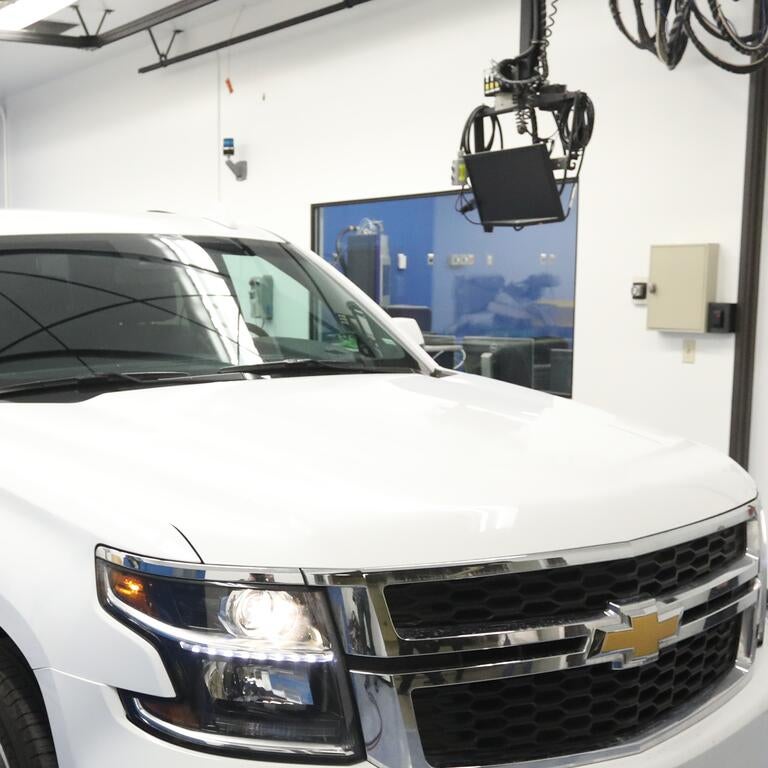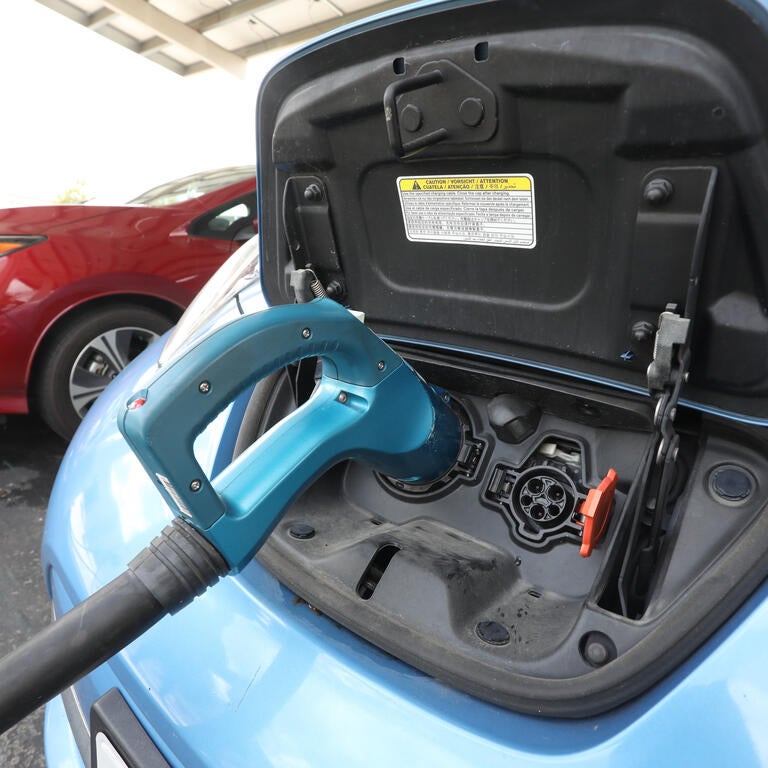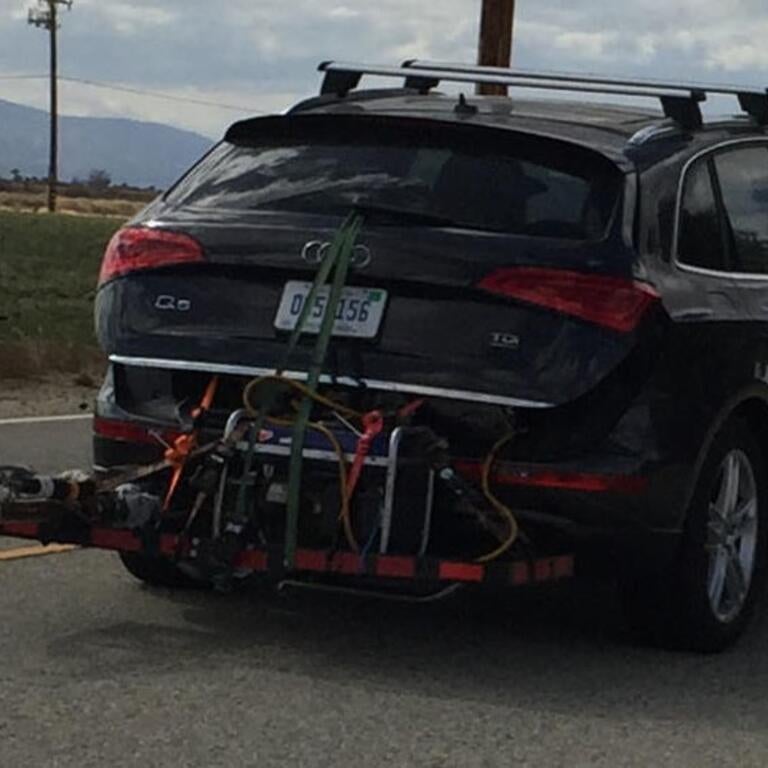Emissions and Fuels Research

About EFR
The Emissions and Fuels research team at CE-CERT, including national and international research leaders, is applying advanced technologies and methods to the measurement of emissions from all types of engines, including cars and light-duty trucks, heavy-duty freight trucks and construction equipment, and the large engines that power marine vessels. CE-CERT has considerable experience with successfully completing complex projects that involve elements of laboratory testing, fieldwork, activity measurements, and PEMS evaluations and implementations.
Programs & Initiatives
Laboratory Services
Kent Johnson
(951) 313-5658
kjohnson@cert.ucr.edu
(951) 313-5658
kjohnson@cert.ucr.edu
-
Cooking Emissions Test Kitchen
Reducing Emissions Through Cleaner KitchensEmissions from commercial and non-commercial kitchens can have a substantial impact on the quality of our air. In addition to cooking by-products such as grease, smoke, and heat, cooking methods such as charbroiling are known to generate large amounts of particulate matter. As a result, several air quality agencies in California are exploring the possibility of requiring cooking operations to install control devices. CE-CERT’s test kitchen facility is designed to capture and analyze the emissions generated by a variety of cooking equipment, providing researchers with data critical to the development of policy around the manufacturing, maintenance, and use of such equipment.Service DetailsFees are billed per basic test day (up to 8 hours) which includes the following:
-
Oversight of manufacturer device installation
-
Ordering of supplies for testing
-
Set up of test equipment
-
Testing
-
Data processing, QA, and reporting
If the same device is to be tested repeatedly, a 10% labor discount can be given for the reduced effort in oversight of new device installation. Please note that the following items are NOT included in the rate listed above: test plan development, data analysis and reporting beyond established standards, negotiation of shipping and delivery details with vendors, or any similar tasks. -
-
Heavy Duty Chassis Dynamometer
Simulating Exacting Road Load and Inertia ForcesCE-CERT is home to a heavy-duty tandem axle truck chassis dynamometer in conjunction with Mustang Dynamometer. The development of the chassis dynamometer design was based on target vehicles in the medium to heavy-duty diesel vehicle range. This high performance 48” Electric Chassis Dynamometer has Dual Direct Connected, 300 Hp AC Motors individually attached to each roll set (model MD-AC/AC-300.48/300.48-45,000lb-HD-TANDEM). The dynamometer is capable of simulating exacting road load & inertia forces to a vehicle operating over a range of different driving conditions including highway cruise, urban driving, and other typical on road driving conditions, with the designed based on 17 different drive cycles. The robust dynamometer can continuously absorb/motor loads in excess of 600 HP from 45 to 80 mph and intermittently absorb/motor loads in the range of 1,200Hp. It is able perform vehicle inertia simulation across a vehicle weight range of 10,000 to 80,000 lb. CE-CERT’s Mobile Emissions Laboratory (MEL) is used directly in conjunction with this facility for certification type emissions measurements.Service DetailsHD chassis testing options:
• Chassis only
• Chassis + Mobile Emissions Laboratory (MEL)
• Prep Day -
Heavy Duty Engine Dynamometer
Evaluating Diesel Devices, Alternative Fuels, Research, and TechnologiesCE-CERT’s Heavy-Duty Engine Dynamometer Test Facility is designed for a variety of applications including verification of diesel after-treatment devices, certification of alternative diesel fuels, and fundamental research in diesel emissions and advanced diesel technologies. The engine dynamometer facility components were provided as a turnkey system by Dyne Systems of Wisconsin. CE-CERT’s Mobile Emissions Laboratory (MEL) is used directly in conjunction with this facility for certification-type emissions measurements. The facility is recognized by CARB for conducting engine dynamometer testing and has been the cornerstone of CARB’s study of biodiesel as part of the Low Carbon Fuel Standard (LCSF). The test cell is equipped with a 600 horsepower (hp) GE DC electric engine dynamometer that was obtained from the EPA’s National Vehicle and Fuels Emission Laboratory in Ann Arbor, MI. The dynamometer is capable of testing approximately 85% of the engines used in on-road applications and will primarily be used for engines in the 300 to 600 hp range. A charge air conditioning system was obtained from Dyno Air of North Carolina to provide temperature/humidity control for the engine intake air with an accuracy of ±2°C from the setpoint.Service DetailsHD engine dynamometer testing options:
• Heavy Duty Dynamometer only
• Heavy Duty Dynamometer + Mobile Emissions Laboratory
• Prep Day -
Marine Emissions Testing Laboratory
Measuring the Concentration of Gases, Particulate Matter (PM) Measurements, and Other Emissions
In-Use Marine Mobile Emissions LaboratoryCE-CERT's marine laboratory features multi-gas analyzers (Horiba PG350) to measure the concentrations of carbon monoxide (CO), carbon dioxide (CO2), oxygen (O2), nitric oxide (NOx), and sulfur oxide (SOx) gasses in raw exhaust, as well as to provide particulate matter (PM) measurements for diluted exhaust. Unlike other portable gas analyzers that rely upon electrochemical sensors, the Horiba PG-350 utilizes the same measurement principles as a permanently installed CEMS and is in compliance with MARPOL ANNEX VI. The methods utilized are state-of-the-art and follow ISO 8178 as well as 1065 measurement protocols.Heavy Fuel Oil (HFO) Marine 2-Stroke Engine Test PlatformCE-CERT is home to a one-of-a-kind marine engine test-stand system for the evaluation of marine fuel emissions, after-treatment systems, and other novel ideas for the marine sector. This laboratory has been operated on commercial heavy fuel oils (HFOs) with a wide range of viscosities.The marine test engine:-
2-stroke Detroit Diesel Model 6-71N (naturally aspirated)
-
In-line 6-cylinder configuration
-
Maximum rated speed of 2300 RPM (range 1100-2300 RPM)
-
Maximum engine power of 187 kW
-
Brake mean effective pressure (BMEP) of 641 kPa
-
Associated rated brake specific fuel consumption (BSFC) of 307 g/kWh (0.505 lb/hp-hr) at 1100 RPM (N70 injectors used during testing).
This type of engine is typically used on small vessels or as an auxiliary engine on ocean-going vessels (OGVs). OGVs usually switch to auxiliary engines when approaching ports or other areas where more maneuvering is required. -
-
Mobile Emissions Laboratory
Measuring the Emissions of Large Stationary EnginesUCR’s Mobile Emission Laboratory (MEL) connects to the total exhaust of a diesel or alternative-fueled heavy duty engine to collect certification grade emissions measurements. The lab is housed inside a tractor trailer, so it can be connected to a heavy duty truck cab and collect measurements while going down the road, transported to any facility to measure and certify large stationary engines, or used in conjunction with UCR’s or others heavy duty engine or chassis dynamometer. MEL collects information on a wide range of pollutants including criteria, toxics, NH3, and particle size and number. MEL is 1065 compliant and is validated with the California Air Resource Board’s and Southwest Research Institute’s heavy-duty diesel laboratories.Service DetailsMEL Testing Options:
• MEL Prep Day
• MEL Test Day
• Additional NH3 (per week) -
Light Duty Emissions Laboratory
Measuring Exhaust Emissions Under Real-World Driving ConditionsAVL Test Systems Inc., in partnership with CE-CERT, has completed the installation of a state-of-the-art laboratory for measuring exhaust emissions under conditions that are representative of real-world driving conditions commissioned in January 2020. The facility meets all CFR 1065/1066 requirements and is located within five miles of the new CARB Southern California headquarters. CE-CERT’s laboratory was designed to be nearly identical to the new test facility at CARB (the same equipment, designs, software, configurations, and firmware). The new CE-CERT LDL facility will be utilized to support advanced low emissions vehicles, hybrids, and electric vehicle performance and will be a leading research and training tool for Southern California. The laboratory includes AVL’s iGEM test cell automation system, capabilities for Ultra low emissions testing (SULEV[20/30], PZEV, other low emissions options), advanced non-regulatory data collection, real-time PM (soot), fuels, blending, fuels impact, and on-road testing. As part of this partnership with AVL, additional in-house expertise will be available through CE-CERT such as combustion analysis tools and other specialized equipment within the AVL portfolio.
-
Portable Emission Measurement System
Measuring Emissions for On-road and Off-road ApplicationsCE-CERT has a fully 1065-approved gaseous and PM PEMS system for on-road and off-road applications. The PEMS utilizes the AVL M.O.V.E. system for gaseous emission measurements and the AVL 494 system for PM measurements. The AVL M.O.V.E. is equipped with a non-dispersive ultraviolet (NDUV) analyzer for measuring oxides of nitrogen (NO and NO2), a non-dispersive infrared (NDIR) analyzer for measuring CO and CO2, and a flame ionization detector (FID) for measuring total hydrocarbons (THC). The gaseous data is measured as a concentration and is time aligned and flow weighted to the exhaust flow for total mass reporting. All time alignment and flow weighting is performed as part of the post-processor systems for both PEMS. The exhaust flow meter is integrated with the gaseous PEMS and is designed to work with a wide range of exhaust flows and dynamics of transient vehicle testing. The exhaust flow meter uses differential pressure as its measurement principle.
Applications include:-
Off-Road Construction Equipment (PEMS on top of the unit shown below)
-
Light Duty Vehicles
-
Trucks and Buses
-
Rail and Marine Vessels
Service DetailsPEMS Testing Options:-
Description
-
Gas PEMS only
-
Gas + PM PEMS
-
Lead staff salary
-
PEMS prep salary
-



